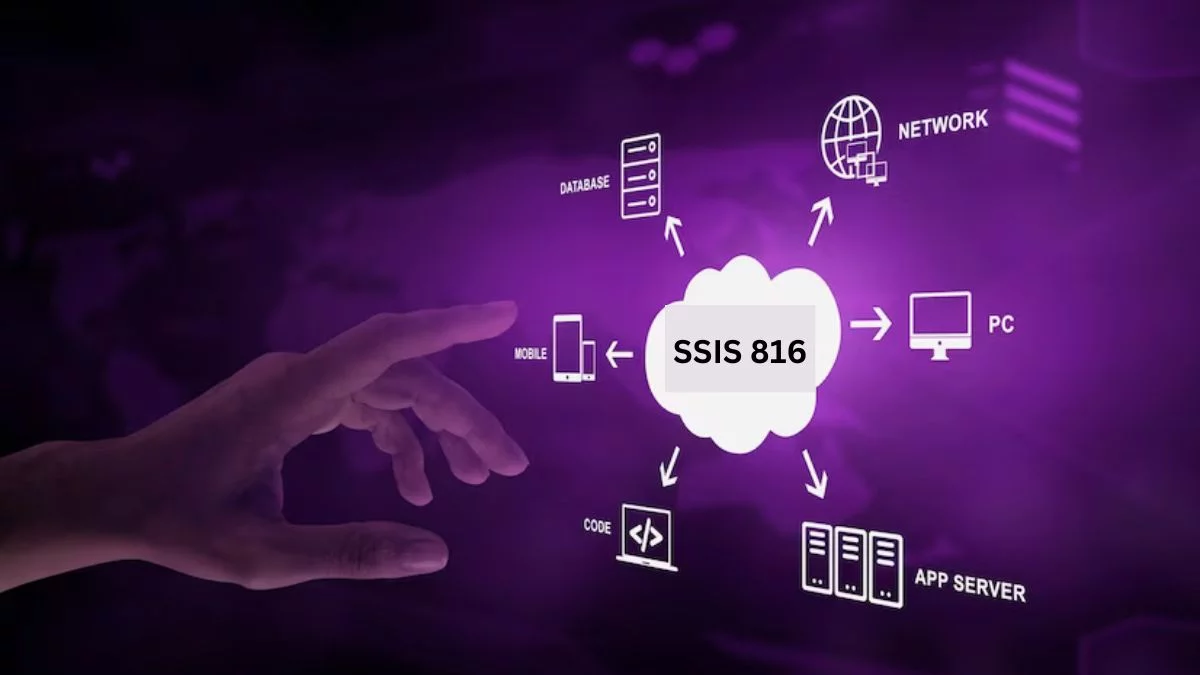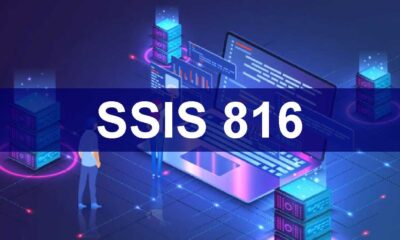Technology
Mastering SSIS 816: Guide for Data Integration

Understanding SSIS 816 is essential for anyone looking to excel in the field of data integration. But what exactly is SSIS 816? It stands for SQL Server Integration Services 2016, which is a powerful tool that allows you to extract, transform, and load data from various sources into your desired destination. With its user-friendly interface and extensive features, SSIS 816 provides a seamless experience for designing and configuring packages. Whether you’re a data analyst or a database administrator, mastering SSIS 816 will undoubtedly elevate your skills and make you an indispensable asset in the world of data integration.
SSIS 816 offers a wide range of benefits that can revolutionize how you handle your data. It enables efficient ETL processes by extracting relevant information from multiple sources, transforming it as required, and loading it seamlessly into your target destinations. Additionally, it facilitates effective data warehousing by enabling the creation of robust solutions for storing large volumes of structured or unstructured data. Furthermore, with its business intelligence capabilities, SSIS 816 empowers organizations to gather valuable insights and make informed decisions based on accurate and timely information. In short, understanding SSIS 816 opens up endless possibilities for streamlining workflows and ensuring optimal utilization of resources within any organization’s data ecosystem
What is SSIS 816?
SSIS 816, also known as SQL Server Integration Services, is a powerful data integration tool developed by Microsoft. It allows users to extract, transform, and load (ETL) data from various sources into relational databases or other destinations. With SSIS 816, you can easily create and manage complex workflows for data integration tasks.
This tool provides a user-friendly interface that makes it easier for developers to design and configure packages. The drag-and-drop functionality enables you to build robust data integration solutions without writing extensive code. SSIS 816 also offers advanced features like error handling, logging, and package deployment options. Whether you’re working on ETL processes, data warehousing projects, or business intelligence initiatives, SSIS 816 can streamline your data integration tasks and improve efficiency in your organization.
Key Features and Benefits of SSIS 816
SSIS 816 comes with a range of key features and benefits that make it an essential tool for data integration. With its intuitive user interface, users can easily navigate through the software and create efficient packages for their data workflows.
One of the standout features of SSIS 816 is its ability to handle complex ETL processes. Whether you need to extract data from multiple sources, transform it into a desired format, or load it into a target destination, SSIS 816 has got you covered. Additionally, this powerful tool enables seamless data warehousing, allowing businesses to store and analyze large volumes of information efficiently.
Moreover, SSIS 816 excels in business intelligence applications by providing robust capabilities for extracting insights from raw data. It offers various built-in tasks and transformations that enable users to manipulate and cleanse data before analysis. This ensures accurate reporting and informed decision-making within organizations.
Furthermore, this versatile tool facilitates smooth data migration between different systems or databases. Whether you’re upgrading your software or consolidating your databases, SSIS 816 simplifies the process by offering easy-to-use tools for mapping source and destination fields.
In addition to these core functionalities, SSIS 816 also supports replication scenarios where real-time synchronization is crucial. Users can set up replication tasks effortlessly using the available components in the package designer.
Another significant benefit of utilizing SSIS 816 is workflow automation. Through its scheduling options and event-driven triggers, users can automate their repetitive tasks effectively without manual intervention.
With all these remarkable features at hand, it’s clear why professionals turn to SSIS 816 when it comes to efficient and seamless data integration solutions.
Getting Started with SSIS 816
How to Download and Install SSIS 816
To begin your journey with SSIS 816, the first step is to download and install the software. Visit the official Microsoft website or trusted third-party sources to ensure you’re getting a legitimate version. Once downloaded, follow the installation wizard prompts to complete the process. It’s important to note that system requirements may vary, so make sure your computer meets the necessary specifications.
Familiarizing Yourself with the User Interface
Once installed, it’s time to familiarize yourself with the user interface of SSIS 816. Take some time exploring different menus and options available within the software. This will help you navigate through various features easily as you start working on your data integration projects. Don’t be overwhelmed by all its functionalities – take it one step at a time and soon enough, you’ll become comfortable navigating through SSIS 816 like a pro!
How to Download and Install SSIS 816
To get started with SSIS 816, the first step is to download and install the software. Fortunately, this process is straightforward and can be done in just a few simple steps.
First, visit the official Microsoft website and navigate to the SQL Server Integration Services page. From there, you can choose the version of SSIS that corresponds to your operating system. Once you’ve selected the appropriate version, click on the download button to begin downloading the installation package.
Once the download is complete, locate the installation file on your computer and double-click it to start the installation process. Follow the prompts provided by the installer, making sure to read each step carefully before proceeding. When prompted for any additional options or configurations during installation, make your selections according to your preferences.
Familiarizing Yourself with the User Interface
The user interface of SSIS 816 is designed to be intuitive and user-friendly. When you first open the application, you will be greeted with a clean and organized layout that allows for easy navigation. The main window is divided into different sections, such as the toolbox, control flow tab, data flow tab, and output window.
To become familiar with the user interface, take some time to explore each section and understand its purpose. The toolbox contains various components that can be dragged and dropped onto the design surface to create your data integration workflows. The control flow tab allows you to define the sequence of tasks in your package while the data flow tab enables you to configure how data moves between sources and destinations.
Getting acquainted with the SSIS 816 user interface is essential for the efficient development of your packages. Take advantage of its organized layout and explore each section’s functionalities to make full use of this powerful tool in your data integration projects.
Creating a New Project
Creating a new project in SSIS 816 is a crucial step in data integration. To begin, simply open the SSIS 816 application and navigate to the “File” menu. From there, select “New Project” to initiate the project creation process.
In the project creation window, you will be prompted to provide a name and location for your new project. It’s important to choose a descriptive name that accurately reflects the purpose of your project. Additionally, selecting an appropriate location ensures easy access to your files.
Once you’ve provided all the necessary information, click on “OK” to create your new project. Congratulations! You’re now ready to start building packages and designing solutions for seamless data integration in SSIS 816. Stay tuned for more tips and tricks as we dive deeper into mastering this powerful tool!
Creating a Package
Creating a Package in SSIS 816 is an essential step in data integration. Once you have created your project, it’s time to design and configure your package. This involves selecting the necessary components from the toolbox, such as data sources, transformations, and destinations.
To create a package, simply drag and drop these components onto the control flow canvas. You can then connect them with arrows to define the sequence of tasks. Next, you’ll need to configure each component by specifying properties like connection strings and mappings. SSIS 816 provides a user-friendly interface for easily managing these configurations.
By creating packages in SSIS 816, you gain complete control over how your data is processed and transformed during integration. Whether you’re extracting data from multiple sources or loading it into various destinations, creating a well-designed package ensures the smooth execution of your ETL processes. So don’t hesitate to dive into SSIS 816 and start building powerful packages today!
Designing and Configuring Your First Package
Designing and configuring your first package in SSIS 816 is an exciting step toward mastering data integration. Once you have created a new project, it’s time to dive into the user interface and start building your package. With drag-and-drop functionality, you can easily add tasks and components to your package, such as extracting data from a source, transforming it using various transformations, and loading it into a destination. You can also customize the settings for each task or component to meet your specific requirements.
To configure your package, simply select the task or component you want to modify and use the properties window to make changes. This includes specifying connection managers for data sources and destinations, defining transformation logic using expressions or scripts, setting error-handling options, and much more. The intuitive interface of SSIS 816 makes it easy for both beginners and experienced users to design complex packages with ease.
Remember that designing and configuring packages may require some trial and error as you test different configurations and fine-tune settings based on your unique scenario. Don’t be afraid to explore the various tools available in SSIS 816 to create robust packages that efficiently handle your data integration needs!
Common Uses and Applications of SSIS 816
ETL (Extract, Transform, Load): One of the primary uses of SSIS 816 is for ETL processes. It allows you to extract data from various sources, transform it according to your business rules or requirements, and load it into a target database or data warehouse.
Data Warehousing: Another common application of SSIS 816 is in building and maintaining data warehouses. With its powerful capabilities for extracting and transforming large volumes of data, you can easily create a centralized repository that enables efficient reporting and analysis.
Business Intelligence: SSIS 816 plays a crucial role in business intelligence initiatives by providing the means to integrate and consolidate disparate data sources. This enables organizations to gain valuable insights through accurate reporting, dashboards, and analytics tools.
Data Migration: When migrating data from one system or platform to another, SSIS 816 comes in handy. Its intuitive interface allows you to map source tables/columns to destination tables/columns effortlessly while ensuring the integrity of the migrated data.
Replication: For organizations with distributed databases that require synchronization between multiple servers or locations, SSIS 816 offers robust replication features. You can easily configure replication tasks using its graphical interface without writing complex code.
Workflow Automation: SSIS 816 enables workflow automation by allowing you to schedule packages at predefined intervals or trigger them based on specific events. This helps streamline repetitive tasks and ensures the timely execution of critical processes within your organization.
ETL (Extract, Transform, Load)
ETL (Extract, Transform, Load) is a crucial process in data integration that plays a vital role in managing and combining large volumes of data from different sources.
The first step, extraction, involves retrieving the relevant data from various databases or applications. Once extracted, the next phase is transformation where the data undergoes cleansing and restructuring to ensure its accuracy and consistency. During the loading stage, the transformed data is loaded into a target database or system for further analysis and reporting.
ETL enables organizations to consolidate their disparate data sources into a unified view for better decision-making. It helps improve data quality by standardizing formats and removing duplicates or errors. With ETL processes powered by SSIS 816, businesses can efficiently integrate and synchronize their valuable information across multiple platforms without manual intervention!
Data Warehousing
Data Warehousing is one of the key applications of SSIS 816. It allows organizations to store and manage large volumes of data in a structured and organized manner. By creating a centralized repository, companies can easily access and analyze their data for reporting and decision-making purposes.
With SSIS 816, you can design robust ETL processes to extract data from various sources, transform it into a consistent format, and load it into the data warehouse. This ensures that the information is accurate, up-to-date, and readily available for analysis. Data warehousing with SSIS 816 provides businesses with valuable insights into their operations, customers, and markets, enabling them to make informed decisions and drive growth.
Business Intelligence
Business Intelligence (BI) is a crucial aspect of any business operation. It involves gathering, analyzing, and transforming data into meaningful insights that can drive strategic decision-making. With SSIS 816, you can easily integrate BI processes into your data flow.
Using the powerful tools and features of SSIS 816, you can extract data from various sources, transform it using advanced algorithms and calculations, and load it into a data warehouse or reporting system. This allows businesses to gain valuable insights from their data and make informed decisions to improve efficiency, identify trends, and optimize performance. With SSIS 816’s intuitive interface and comprehensive capabilities for Business Intelligence tasks, harnessing the power of your data has never been easier!
Data Migration
Data migration is a crucial aspect of any organization’s data management strategy. Whether it’s moving data from one system to another or consolidating data from multiple sources, SSIS 816 provides a powerful and efficient solution. With its intuitive interface and robust features, you can easily map and transform your data to ensure a seamless migration process.
By leveraging the capabilities of SSIS 816, you can automate the extraction, transformation, and loading of your data across different platforms and environments. This not only saves time but also minimizes the risk of errors during the migration process. From validating source data to handling complex mapping scenarios, SSIS 816 equips you with the tools needed to successfully migrate your data while maintaining its integrity and consistency.
Replication
Replication is a crucial aspect of data management that plays a significant role in SSIS 816. It allows you to distribute and synchronize data across multiple servers, ensuring consistency and availability. With replication, you can replicate entire databases or selected tables, making it ideal for scenarios where you need real-time updates across multiple locations.
By using replication in SSIS 816, you can easily create copies of your data at different sites without the need for manual intervention. This ensures that all your teams have access to the most up-to-date information, improving collaboration and decision-making processes. Additionally, replication enables failover support, allowing you to switch to another server seamlessly in case of any issues with the primary one.
Workflow Automation
Workflow Automation is a key application of SSIS 816 that can streamline and optimize your business processes. By automating repetitive tasks and workflows, you can save time and increase efficiency. With SSIS 816, you can design complex workflows with ease, incorporating various data sources, transformations, and actions to create a seamless automated process.
With the ability to schedule package execution and set up event-driven triggers, you can ensure that your workflows run on time and respond to specific conditions or events. This enables you to automate routine tasks such as data extraction, transformation, loading into databases or data warehouses, generating reports, and sending notifications or alerts based on predefined rules or criteria. Overall Workflow Automation helps in reducing manual effort while improving accuracy and consistency in handling business processes.
Troubleshooting Tips for SSIS 816
Review Error Messages: When encountering an error in SSIS 816, take the time to carefully read and understand the error message. This can provide valuable insight into what went wrong and how to fix it.
Check Connections: Ensure that all connections are properly configured and functioning correctly. Double-check connection strings, credentials, and permissions to avoid any issues with data transfer or connectivity.
Verify Source Data: Before running a package in SSIS 816, verify that the source data is accurate and formatted correctly. Incorrect or incomplete data can lead to errors during extraction or transformation processes.
Use Debugging Tools: Utilize the debugging tools available in SSIS 816 to step through your package’s execution and identify any issues along the way. Breakpoints, variable watchers, and logging options can help pinpoint where problems may arise.
By following these troubleshooting tips for SSIS 816, you’ll be equipped with strategies to overcome common challenges that may arise during your data integration projects. Remember, understanding error messages, checking connections and source data integrity, as well as utilizing debugging tools will help streamline your workflow when using SSIS 816
Review Error Messages
When working with SSIS 816, encountering errors is inevitable. However, understanding and resolving these errors is crucial for successful data integration. One of the key steps in troubleshooting is to review the error messages generated by SSIS.
Error messages provide valuable insights into what went wrong during the execution of a package or task. They often contain specific details about the nature of the error, such as missing or invalid data, connection issues, or syntax errors. By carefully examining these messages, you can quickly identify and address the root cause of any failures. Don’t overlook this important step in your journey towards mastering SSIS 816!
Check Connections
Checking Connections is an essential step in ensuring the smooth functioning of your SSIS 816 projects. When dealing with data integration, it’s crucial to verify that all connections between source and destination systems are properly established and working correctly.
By thoroughly checking connections, you can identify any potential issues or errors early on in the process. This allows you to address them promptly, preventing any disruptions or delays in your data integration workflow. Whether it’s a database connection or a network connection, taking the time to check and validate each one will help ensure the seamless execution of your SSIS 816 packages. So don’t overlook this crucial step – double-check those connections before moving forward!
Verify Source Data
To ensure the accuracy and reliability of your data integration process, it is crucial to verify the source data before proceeding. This step involves carefully examining the data to confirm its integrity and consistency. By verifying the source data, you can identify any errors or inconsistencies that may impact the effectiveness of your SSIS 816 package.
One way to verify your source data is by comparing it against a trusted reference dataset. This can help you identify any discrepancies or missing information that needs to be addressed. Additionally, you can run validation checks on the source data using SQL queries or other tools to ensure that it meets the required criteria for successful integration. Taking these steps will help minimize potential issues and improve overall data quality in your SSIS 816 project.
Use Debugging Tools
When working with SSIS, it’s important to have a solid understanding of debugging tools. These tools allow you to identify and fix any issues or errors in your packages, ensuring smooth data integration. The debugging process involves tracing the flow of data within your package, monitoring variables and expressions, and analyzing error messages.
One useful tool for debugging in is the Data Flow Path Editor. This tool allows you to examine the data flow paths used in your package and view properties such as source columns and transformations applied. By using this tool, you can pinpoint any bottlenecks or inconsistencies in your data flow, making it easier to troubleshoot and optimize your package.
In addition to the Data Flow Path Editor, also provides the Script Task Debugging feature. This allows you to execute custom scripts within your package during runtime and monitor their behavior. By stepping through each line of code, you can identify any logic errors or unexpected results that may be causing issues.
By leveraging these debugging tools effectively, you can ensure that your SSIS packages are running smoothly without any hiccups or errors along the way
Conclusion
SSIS 816 is a powerful tool for data integration, offering a wide range of features and benefits. From its intuitive user interface to its ability to handle complex ETL processes, SSIS provides users with the tools they need to efficiently manage their data workflows.
In addition, SSIS 816 has various applications in fields such as data warehousing, business intelligence, and workflow automation. With troubleshooting tips available for resolving any issues that may arise during usage, this comprehensive guide ensures that you have all the information you need to become a master of SSIS.
Technology
The Benefits of Eco-Friendly Powder Coating Booths

Eco-friendly powder coating booths are revolutionizing the industrial and commercial coating industry. As environmental concerns continue to rise, businesses are seeking sustainable solutions to reduce their carbon footprint and improve efficiency. Modern powder coating booths not only offer superior performance but also align with green initiatives, making them a popular choice among manufacturers and professionals. Here are some unique benefits of eco-friendly powder coating booths that many may not be aware of.
Superior Energy Efficiency
One of the standout benefits of eco-friendly powder coating booths is their superior energy efficiency. Traditional coating methods often require high energy consumption, but modern powder coating booths are designed to minimize energy use. These booths incorporate advanced technologies such as VFD (Variable Frequency Drive) airflow control, which adjusts the airflow based on the booth’s operational needs. This feature not only reduces energy consumption but also enhances the overall efficiency of the coating process. High-efficiency powder coating booths contribute significantly to lowering operational costs and reducing the environmental impact of industrial activities.
Enhanced Air Quality
Eco-friendly powder coating booths are engineered to improve air quality within the workspace. Traditional coating processes can release harmful VOCs (Volatile Organic Compounds) into the air, posing health risks to workers and contributing to environmental pollution. High-tech powder coating booths, on the other hand, use filtration systems that capture and contain overspray particles, preventing them from escaping into the atmosphere. These systems typically include multi-stage filters, such as primary blanket filters, polyester cube filters, and MERV 14+ final filters, which ensure that the air released from the booth is clean and safe. This focus on air quality not only protects workers’ health but also supports a healthier environment.
Reduction in Waste and Material Usage
Eco-friendly powder coating booths are designed to minimize waste and optimize material usage. Unlike traditional liquid coatings, powder coatings can be collected and reused, significantly reducing the amount of waste generated. This reclaim system is a key feature of custom powder coating booths, allowing operators to recover and recycle excess powder. Additionally, the precise application techniques used in these booths ensure that the coating material is evenly distributed, reducing the need for multiple coats and further decreasing material usage. This efficiency not only leads to cost savings but also aligns with sustainable practices by minimizing resource consumption.
Adaptable Functions and Personalized Setup
Eco-friendly powder coating booths offer remarkable versatility and customization options, making them suitable for a wide range of applications. Whether it’s a small powder coating booth for coating wheels and cycle frames or a large powder coating booth for aviation and heavy equipment, these booths can be tailored to meet specific needs. Custom powder coating booths can be designed with various configurations, integrated parts conveyors, automated powder spraying equipment, and split-top designs. This adaptability ensures that businesses can achieve optimal results for different coating projects while maintaining environmental responsibility. The ability to customize booths also means that they can be optimized for energy efficiency and waste reduction, further enhancing their eco-friendly credentials.
Simplified Maintenance and Longevity
Maintaining eco-friendly powder coating booths is relatively straightforward, thanks to their robust construction and advanced features. The booth walls and roof are typically made of durable, galvanized steel, ensuring long-lasting performance and minimal maintenance requirements. Powder coating booth maintenance is further simplified by features such as self-cleaning cartridge filtration systems and easy-to-access control panels. These systems allow operators to clean the primary filters using pulsed air, reducing downtime and maintaining optimal booth performance. High-tech powder coating booths are designed to withstand the rigors of industrial use while providing consistent, high-quality results. This durability not only extends the lifespan of the booths but also reduces the need for frequent replacements, contributing to sustainability.
Eco-friendly powder coating booths represent a significant advancement in industrial and commercial coating technology. By prioritizing energy efficiency, air quality, waste reduction, versatility, and simplified maintenance, these booths offer substantial benefits that go beyond traditional coating methods. Businesses that invest in professional powder coating booths not only enhance their operational efficiency but also demonstrate a commitment to environmental responsibility. As the demand for sustainable solutions continues to grow, eco-friendly powder coating booths will play a crucial role in shaping the future of the coating industry.
Technology
Enhance Your Concealed Carry Experience with DeSantis Gunhide Holsters

Key Takeaways:
- ability, and security for concealed carry enthusiasts.
- Understanding different types of holsters and their benefits can guide your purchase decision.
- Proper maintenance and care for your holster ensure longevity and consistent performance.
Why Choose DeSantis Gunhide Holsters?
For those serious about concealed carry, DeSantis holsters provide an excellent blend of quality and reliability. These holsters are designed with functionality and comfort, ensuring your weapon is secure and easily accessible. The brand’s commitment to innovation sets them apart in the crowded market of firearm accessories. From the materials used in construction to the design philosophy, every aspect of a DeSantis holster is crafted with the user’s needs in mind. Research has shown that holster choice directly influences the overall success of concealed carry by providing security and comfort. This makes understanding your holster options critical. Without a reliable holster, the effectiveness of concealed carrying can be significantly diminished, potentially compromising safety and quick accessibility.
The Importance of Concealed Carry Holsters
Concealed carry holsters are critical in the practical, safe, and legal carrying of firearms. They offer security while ensuring that the gun is hidden and accessible. Selecting the right holster is an important decision that impacts your safety and those around you. A good holster ensures the firearm is secure, reduces the risk of accidental discharge, and facilitates quick access when needed.
Finding the right fit and style tailored to your needs enhances comfort and confidence.
Final Thoughts
DeSantis holsters provide an excellent combination of form, function, and reliability. By understanding your needs and the options available, you can significantly enhance your concealed carry experience. Pay attention to customer feedback, maintain your holster correctly, and you’ll ensure it serves you well for years to come. So, whether you’re new to concealed carry or a seasoned practitioner, investing in a quality holster like DeSantis gunhide is a step in the right direction. Your holster choice can substantially impact your concealed carry experience, providing peace of mind and reliable performance.
Technology
Essential Car Parts to Check Before Selling Online in Clearwater, FL

Getting ready to sell your car online in Clearwater FL? Smart move – cutting out the dealerships lets you get top dollar. But before you list that car, there are some essential things you’ll want to check over. Little problems that seem no big deal could leave buyers running for the hills. Give these key areas a once-over first, and you’ll be setting yourself up to show your car’s true value to interested buyers.
Cabin Air Filter
The cabin air filter plays a significant role in maintaining a comfortable and healthy environment inside your car. It filters out dust, pollen, and other airborne particles, ensuring clean air for you and your passengers. Over time, this filter can become clogged, reducing its effectiveness and potentially causing unpleasant odors. Replacing the cabin air filter is a simple yet impactful way to show buyers that you take maintenance seriously. This small investment can make a big difference when you sell your car in Clearwater, FL.
Serpentine Belt
The serpentine belt is a critical component that drives multiple peripheral devices in your vehicle, such as the alternator, power steering pump, and air conditioning compressor. A worn or damaged serpentine belt can lead to a host of problems, including a complete breakdown. Inspect the belt for signs of wear, such as cracks, fraying, or glazing. If you notice any issues, replace the serpentine belt before listing your car. Buyers will be reassured knowing that this essential part has been recently checked and, if necessary, replaced.
Radiator Hoses
Radiator hoses are responsible for circulating coolant between the engine and the radiator, preventing your engine from overheating. Over time, these hoses can deteriorate, leading to leaks and potential engine damage. Inspect the hoses for signs of wear, such as cracks, bulges, or leaks. Replacing worn-out radiator hoses can prevent future problems and give buyers confidence in the reliability of your car. A well-maintained cooling system is a strong selling point when you want to sell your car in Clearwater, FL.
Brake Pads
Brake pads are one of the most critical safety components in your car. Worn-out brake pads can compromise your ability to stop effectively, posing a serious risk to you and future owners. Check the thickness of your brake pads and listen for any squeaking or grinding noises indicating they need replacing. Ensuring that your brake pads are in good condition enhances safety and boosts buyer confidence. Safety-conscious buyers in Clearwater, FL, will appreciate the attention to this crucial detail when you sell your car.
Wheel Bearings
Wheel bearings are essential for the smooth and efficient rotation of your wheels. They support the weight of your vehicle and ensure a smooth ride. Over time, wheel bearings can wear out, leading to vibrations, noise, and even wheel failure. Inspect your wheel bearings for signs of wear, such as rumbling noises or uneven tire wear. Replacing faulty wheel bearings can improve the overall driving experience and reassure buyers of your car’s quality. A smooth, noise-free ride is a strong selling point when you sell your car in Clearwater, FL.
Selling Your Car in Clearwater, FL
When preparing to sell your car, focusing on these essential parts can significantly enhance your car’s appeal and value. Buyers will appreciate the extra effort you’ve put into maintaining your vehicle, making them more likely to offer a fair price. sell your car online in Clearwater FL Whether it’s replacing the cabin air filter or ensuring the wheel bearings are in top condition, these checks can make a big difference. By addressing these key areas, you’re not just selling a car; you’re offering peace of mind to the next owner.
In conclusion, taking the time to check and, if necessary, sell your car online in Clearwater FL replace these essential car parts can help you sell your car in Clearwater, FL, quickly and at a good price. A well-maintained vehicle speaks volumes about its owner and can make all the difference in a competitive market. Ensure your car stands out by presenting it in the best possible condition.
-

 Fashion7 months ago
Fashion7 months agoλιβαισ: An Ageless Tradition of Denim and Fine Handicraft
-

 Technology5 months ago
Technology5 months agoA Comprehensive Guide to the Meaning and Significance of FTMÇ·
-

 Lifestyle7 months ago
Lifestyle7 months agoIlikecomox: A Journey of Discovery
-

 Health6 months ago
Health6 months agoWell Health how to Build Muscle and Boost Your Strength
-

 Health7 months ago
Health7 months agoHow to Build Muscle with WellHealth: A Comprehensive Guide
-

 Technology8 months ago
Technology8 months agoPixwox: Unleashing the Magic of Digital Art and Creativity
-

 Business8 months ago
Business8 months agoWells Fargo login Online Banking
-

 Business8 months ago
Business8 months agoКинокрадко – A Serious Threat to Film Industry!


